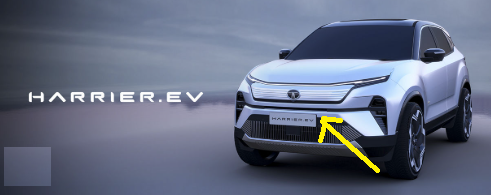Introduction to the Tata Harrier EV
Tata Motors has been making significant strides in the electric vehicle (EV) space, with the Tata Harrier EV being one of its most anticipated releases. The Harrier, a popular SUV in India, has already made a name for itself with its stylish design, rugged performance, and solid build quality. With the Harrier EV, Tata aims to blend those same qualities with sustainability and the benefits of electric mobility.
Recent reports indicate that the Tata Harrier EV has been spotted undergoing real-world testing, and early insights into its new features and performance specs have been disclosed. If you’re curious about what this electric SUV will bring to the table, keep reading as we break down all the important details.
Tata Harrier EV: What’s New?
The Harrier EV is not just a rehash of its petrol counterpart, the Tata Harrier, but rather a comprehensive upgrade that brings electric power to the forefront. Here’s what we know so far:
1. Powertrain and Performance
The Tata Harrier EV is expected to feature a robust powertrain designed to offer both performance and efficiency. Based on reports from testing, the vehicle is likely to be equipped with a powerful electric motor that provides impressive torque for smooth acceleration. While the exact power output is yet to be officially confirmed, sources suggest that the EV could offer power figures in the range of 130-150 kW, translating to a good balance of performance for city driving and highway cruising.
Additionally, the Harrier EV will come with a large battery pack, possibly in the range of 60-70 kWh, ensuring a decent driving range per charge. The battery technology will likely include fast-charging capabilities, enabling the vehicle to charge from 0 to 80% in under an hour using fast chargers, making it suitable for long-distance travel.
2. Range and Efficiency
One of the key aspects that will define the success of any electric vehicle is its driving range. The Tata Harrier EV is expected to offer a range of around 400-500 km on a single charge, depending on driving conditions and the battery variant chosen. This would place the Harrier EV in direct competition with other electric SUVs like the MG ZS EV and Hyundai Kona Electric, both of which have a similar range.
The efficient powertrain, combined with advanced regenerative braking systems, will help maximize efficiency and range, ensuring that the Harrier EV can meet the needs of most urban and suburban drivers.
3. Design and Interior
In terms of design, the Tata Harrier EV is expected to closely follow the styling of its combustion engine counterpart, with subtle differences to highlight its electric nature. Expect to see a sleeker front grille with a closed-off design, which is common among electric vehicles, as well as redesigned elements to improve aerodynamics and enhance the overall efficiency of the vehicle.
Inside, the Tata Harrier EV will offer a spacious cabin that’s designed for comfort and convenience. Premium materials, a modern infotainment system, and advanced connectivity features are expected to make the Harrier EV a strong contender in the electric SUV market. Additionally, Tata Motors is likely to incorporate a large touchscreen infotainment system with support for Apple CarPlay, Android Auto, and perhaps even new features like voice controls.
4. Advanced Features and Technology
As with most new vehicles, the Tata Harrier EV will be packed with advanced tech and safety features. Expect the following:
- ADAS (Advanced Driver Assistance Systems): The Harrier EV is expected to feature driver assistance technologies like lane keep assist, automatic emergency braking, adaptive cruise control, and more, enhancing overall safety.
- Connected Car Technology: Tata Motors has been incorporating smart technology in its vehicles, and the Harrier EV will likely be equipped with an advanced infotainment system that offers real-time data on battery levels, range, and charging stations. Additionally, it could feature over-the-air (OTA) updates to keep the system up-to-date.
- Climate Control and Smart Features: Expect features like automatic climate control, a panoramic sunroof, and a premium audio system, enhancing the overall driving experience.
Tata Harrier EV Price and Launch Details
While Tata Motors has not officially confirmed the price of the Harrier EV, it’s expected to be positioned in the premium electric SUV segment. We could see the starting price somewhere between ₹25-30 lakh, making it a relatively affordable option compared to other electric SUVs in India.
The official launch of the Harrier EV is expected to take place sometime in mid-2025, with test drives and bookings opening a few months before that. This will give potential buyers a chance to experience the vehicle firsthand before it becomes widely available.
Why the Tata Harrier EV Will Be a Game Changer
The Tata Harrier EV has the potential to make a significant impact on India’s EV market. With increasing consumer demand for electric vehicles and rising environmental awareness, Tata Motors is positioning the Harrier EV as a key player in the transition to sustainable mobility.
The vehicle offers the perfect blend of performance, design, and technology, while maintaining a relatively affordable price point compared to other electric SUVs in the market. Additionally, Tata Motors’ strong after-sales service and extensive dealership network across India will further solidify the Harrier EV as a top choice for Indian consumers looking to make the switch to electric.
Conclusion
The Tata Harrier EV is shaping up to be a game-changer in India’s electric vehicle segment. With its combination of impressive performance, cutting-edge technology, and stylish design, it’s clear that Tata Motors is committed to offering a product that caters to both the practical needs and desires of electric vehicle buyers. As we await its official launch in 2025, the Harrier EV is undoubtedly one of the most exciting EVs on the horizon.

